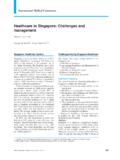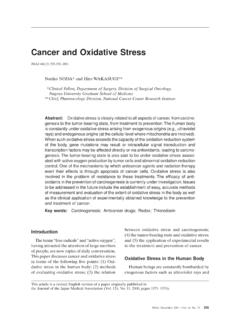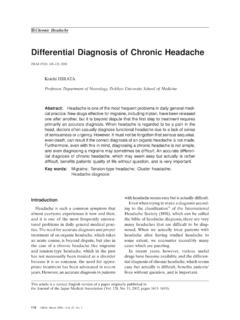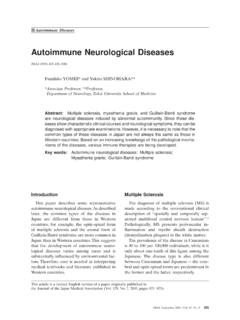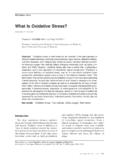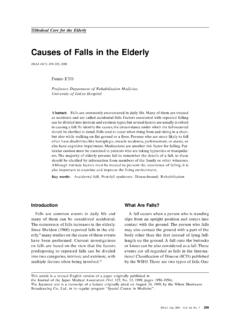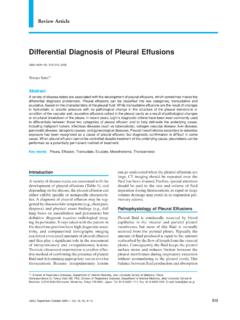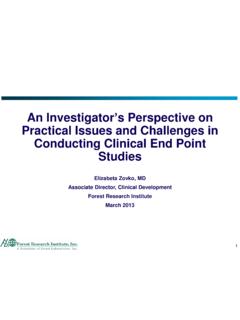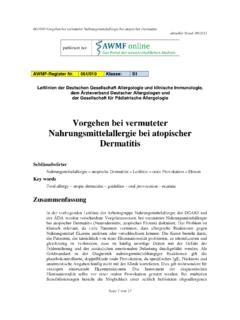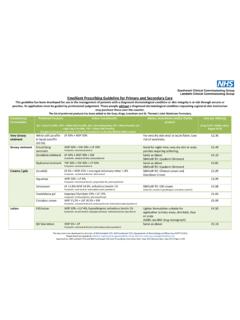Transcription of Diagnostic Standard for Atopic Dermatitis - Med
1 460 JMAJ, November 2002 Vol. 45, No. 11 Diagnostic Standard for Atopic DermatitisJMAJ 45(11): 460 465, 2002 Joji TADAD irector, Division of Dermatology, Okayama Municipal HospitalAbstract:For a dermatologist, the diagnosis of Atopic Dermatitis (AD) is relativelyeasy. In view of the fact that the increase and exacerbation of AD, confusion overits treatment and prevalence of abundant but not necessarily correct informationare creating social issues in Japan, diagnosis and treatment of AD based onprecise cognition are extremely important. While Hanifin and Rajka s diagnosticstandard is known worldwide, a Standard that is easily appreciated and handy foruse by non-dermatologists is needed as many AD patients are being treated indepartments of pediatrics, allergy, etc.
2 In this context, the Diagnostic standardestablished by the Japanese Dermatological Association is quite meaningful. Bycomparing the Standard with other previously published Diagnostic standards , thispaper discusses in detail the main items of pruritis , exanthematous features andtheir distribution and chronically relapsing course , and emphasizes differentialand exclusion words: Atopic Dermatitis ; Diagnostic Standard ; Pruritis;Differential diagnosisIntroductionAtopic Dermatitis (AD) is diagnosed withrelative ease based on its clinical symptomsregardless of sex or age of the patients. Butnot all the diagnoses are correctly concept of AD proposed by Wise et al.
3 (Table 1)1) in 1933 has been accepted world-wide, and AD is now defined as a diseasemainly consisting of eczematous lesions withitch, following the course of exacerbations andremissions, and many of the patients haveThis article is a revised English version of a paper originally published inthe Journal of the Japan Medical Association (Vol. 126, No. 1, 2001, pages 22 26).Table 1 Concept of AD by Wise and Sulzberger1)(1) Family history of Atopic diseases(2) Preceded by infantile eczema(3) Localization to cubital and popliteal fossae, forehead,anterior thorax and face, particularly eyelids(4) Presence of gray to brownish skin(5) Absence of clinical and histological vesicles(6) Instability or easy irritability of vasomotor nerves(7) Patch tests with many irritating contact substances areusually negative(8) Instant positive wheal reaction against many scratch orintradermal tests(9) Presence of much serum regains Atopic DermatitisJMAJ, November 2002 Vol.
4 45, No. 11461 DIAGNOSIS FOR Atopic DERMATITISand allergic the increase and exacerbation of AD,confusion over its treatments, and abundanceof not necessarily correct information over ADare creating social problems today, the diag-nosis and treatment based on precise cognitionof AD is extremely important. As many ADatopic predisposition. 2) AD is, however, a com-plex inflammatory disease with Type I and IVallergies combined in a complicated manner,and not all the patients have Atopic predisposi-tions. In view of these points, it is necessary torecognize that AD is clearly different fromother Atopic diseases such as bronchial asthmaTable 2 Definition and Diagnostic Criteria for Atopic Dermatitis by The Japanese Dermatological AssociationDefinitionAtopic Dermatitis is a pruritic, eczematous dermatosis, the symptoms of which chronically fluctuate with remissions andrelapses.
5 Most individuals with Atopic Dermatitis have Atopic diathesis: (1) Personal or family history (asthma, allergic rhinitis and/or conjunctivitis, and Atopic Dermatitis ), and/or (2) Predisposition to overproduction of immunoglobulin E (IgE) Criteria for Atopic Dermatitis1. Pruritus2. Typical morphology and distribution:(1) Eczematous Dermatitis Acute lesions: erythema, exudation, papules, vesiculopapules, scales, crusts Chronic lesions: infiltrated erythema, lichenification, prurigo, scales, crusts(2) Distribution SymmetricalPredilection sites: forehead, periorbital area, perioral area, lips, periauricular area, neck, joint areas of limbs, trunk Age-related characteristics*Infantile phase: starts on the scalp and face, often spreads to the trunk and extremities*Childhood phase: neck, the flexural surfaces of the arms and legs*Adolescent and adult phase.
6 Tendency to be severe on the upper half of body (face, neck, anterior chest, and back)3. Chronic or chronically relapsing course (usually coexistence of old and new lesions):*More than 2 months in infancy*More than 6 months in childhood, adolescence, and adulthoodDefinite diagnosis of Atopic Dermatitis requires the presence of severity. Other cases should be evaluated on the basis of theclinical course with the tentative diagnosis of acute or chronic, non-specific Diagnosis Contact Dermatitis Seborrheic Dermatitis Prurigo simplex Scabies Miliaria Ichthyosis Xerotic eczema Hand Dermatitis (non- Atopic ) Diagnostic Aids Family history (bronchial asthma, allergic rhinitis and/or conjunctivitis, Atopic Dermatitis ) Complications (bronchial asthma, allergic rhinitis and/or conjunctivitis) Follicular papules (goose-skin) Elevated serum IgE levelClinical Types (not applicable to the infantile phase)
7 Flexural surface type Extensor surface type Dry form in childhood Head face upper neck upper chest back type Prurigo type Erythroderma type Combination of various types are commonSignificant Complications Ocular complication (cataracts and/or retinal detachment): especially in patients with severe facial lesions Kaposi s varicelliform eruption Molluscum contagiosum Impetigo contagiosa462 JMAJ, November 2002 Vol. 45, No. 11In 1980, Hanifin and Rajka modified andcombined their respective standards and pro-posed a new Diagnostic Standard (Table 3).6)This Standard cited the essential three featuresof Hanifin plus the individual or the family his-tory of Atopic disease as an essential feature,and proposed to diagnose AD when the patientmeets at least three of these four items and alsoat least three of 23 minor features.
8 This diag-nostic Standard is being relied on worldwidetoday, but many minor features are somewhattedious. These minor features are being re-patients are being treated in non-dermatologydepartments such as pediatrics and allergy, adiagnostic criterion that is easily appreciatedand handy for use by non-dermatologists isneeded, and the significance of the diagnosticstandard prepared by the Japanese Dermato-logical Association (Table 2)2) is quite meaning-ful in this attention should be paid, however,to diagnoses for exclusion in the after seven years since its publication, weoften encounter patients with contact dermatitiscaused by external preparations and non-drugsthat have been prescribed for treatment pur-poses, or those whose AD has become exacer-bated by ) A physician unable todiagnose eczema lesions accurately by differ-entiating them as true AD lesion or complica-tion of contact Dermatitis is not qualified todiagnose ,5)I would like to discuss the Diagnostic stan-dards of AD, its clinical features, and usefulitems for Standards4,5)
9 Several standards and guidelines for thediagnosis of AD have been published, all ofwhich are substantially the same as the diseaseconcept of AD published by Wise et ) (Table1). Rajika published the Diagnostic standardof AD in 1961 for the first time in the it is somewhat insufficient from thecontemporary standpoint, its historical signifi-cance is 1977, Hanifin et al. cited three essentialfeatures of (1) pruritis, (2) typical morphologyand distribution of eruptions, and (3) chroniccourse of Dermatitis . They further cited 13 fea-tures related to Type I allergy, physiologicalfunctions of the skin and complications, dividedthem roughly into two groups (four and nine),and proposed to diagnose AD when the patientmeets two out of the four features of the formergroup or at least four out of nine of the 3 Diagnostic Standard of Hanifin & Rajika6)1.
10 Must have three or more basic features described below(1) Pruritus(2) Typical morphology and distributionFlexural lichenification in adultsFacial and extensor eruptions in infants and children(3) Chronic or chronically relapsing Dermatitis (4) Personal or family history of atopy (asthma, allergicrhinitis, Atopic Dermatitis )2. Must have three or more following minor features:(1) Xerosis(2) Ichthyosis/palmar hyperlinearity, keratosis pilaris(3) Immediate (type I) skin test reaction(4) Elevated serum IgE(5) Early age of onset(6) Tendency toward cutaneous infections (especiallystaph. aureus and herpes simplex), impaired cell-mediated immunity(7) Tendency toward non-specific hand or foot Dermatitis (8) Nipple eczema(9) Cheilitis(10) Recurrent conjunctivitis(11) Dennie-Morgan infraorbital fold(12) Keratoconus(13) Anterior subcapsular cataracts(14) Orbital darkening(15) Facial pallor, facial erythema(16) Pityriasis alba(17) Anterior neck folds(18) Itch when sweating(19) Intolereance to wool ad lipid solvents(20) Periofollicular accentuation(21) Food intolerance(22) Course influenced by environmental and emotionalfactors(23) White dermographism, delayed blanchJ.
